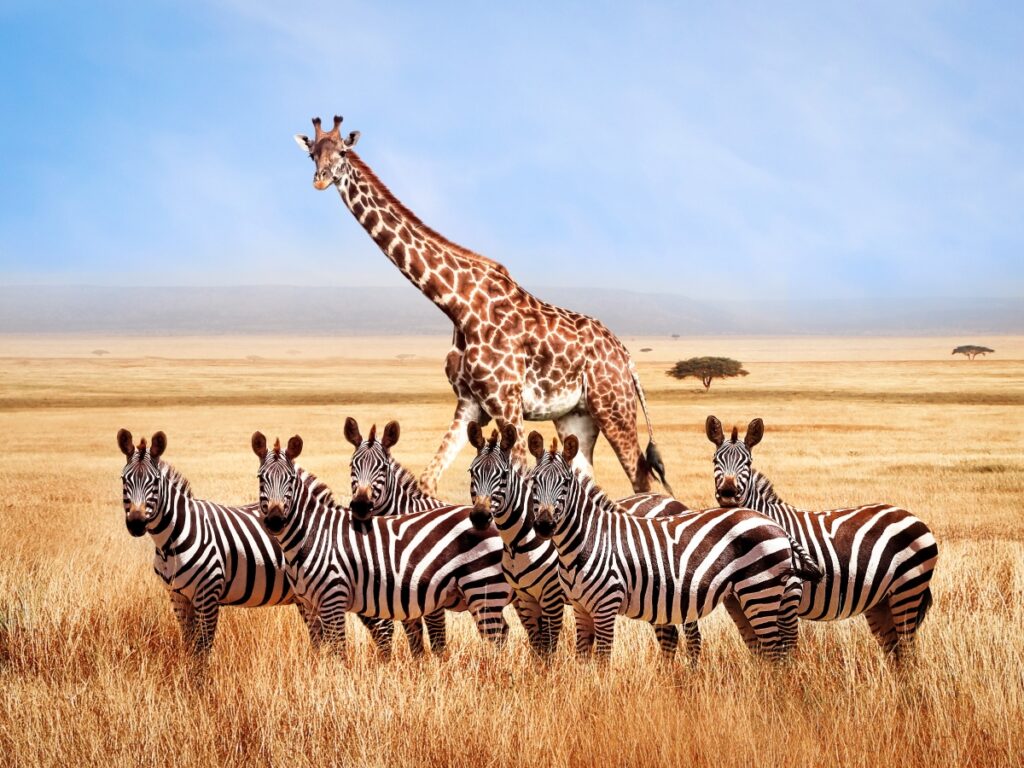“Everything you see exists together in a delicate balance. As king, you need to understand that balance and respect all the creatures, from the crawling ant to the leaping antelope.” ~ Mufasa
Thirty years ago, the Disney movie the Lion King was released, telling the story of Simba, a young lion prince, who, after the murder of his father Mufasa, flees his kingdom only to learn the true meaning of responsibility and bravery. Other memorable characters are the warthog Pumbaa, the red-billed hornbill Zazu, the mandrill Rafiki, and the meerkat Timon—all species that play a role in the richly biodiverse ecosystems of east Africa.

Partly because of this movie, and zoo visits, children and adults around the world are familiar with the wildlife of the iconic landscapes of east Africa. In the transboundary region of southern Kenya and northern Tanzania (or “SOKNOT”), large, protected areas we all have heard of —the Serengeti, Mount Kilimanjaro and Amboseli National Parks, Tsavo National Park—were established back in the 1950s and 60s to ensure the persistence of the vast populations of wildebeest, zebras, and elephants. Today, wildlife is still teeming in the parks, providing the basis for a tourism industry that contributes over 8% of the Gross Domestic Product (GDP) of Kenya and 17% of Tanzania.
Migrating in response to the greening of the landscape in the wet seasons and the disappearing of water sources in the dry seasons, many of the species move on a regular basis between the protected areas, which means that by themselves the areas are not big enough to support the populations.
In the landscapes in between the parks, people are living, farmers are growing corn and other staple foods, and pastoralists are herding cattle, goats, and sheep. These activities at low intensity allow wildlife to live relatively undisturbed and move freely through the landscape. However, pressure on the land in between the parks has been increasing as the human population grows and climate change modifies that region.
As most pressure on the land comes from the increasing human population, climate change makes the wildlife move more, especially to find water during droughts. Greater concentrations of livestock lead to overgrazing, grasslands are converted to row crops, hunting for subsistence leaves areas empty of mammals larger than a hedgehog, and new roads and railroads bisect habitat. Already these pressures threaten native wildlife, and Kenya’s and Tanzania’s populations are expected to double by 2050.
Seeing these threats increasing, both countries have acted. In Kenya, researchers mapped movement pathways of several key species based on movement and presence data and a recent study conducted by The Nature Conservancy modeled corridors between Kenya’s large protected areas. In Tanzania, corridors through the areas with the lowest human impact have been delineated and, thanks to strong corridor legislation, are now being recognized by the government. Several representatives of non-governmental organizations (NGOs) and governments, working with the local communities, are taking steps to secure some of the corridors.
As in any transboundary region, there are challenges, especially for protecting corridors crossing the international border. For example, different policies around natural resource management can lead to conflict, and different conservation approaches may be needed in the same corridor depending on whether or not the land is privately owned.
As landscape use is changing and conservation actions are taken, it is of fundamental importance to know how functional the corridors are for different species, i.e. how well the animals can move through them from one protected area to another. If the landscape in the between the parks is converted to settlements and agriculture—but the corridors remain open—will there be functional connectivity for lions, cheetah, African wild dogs, elephants, zebra, and giraffe?
It will be crucial to develop an early warning system that alerts conservation practitioners to changes in a corridor that, without intervention, may lead to loss of connectivity. For planners and decision makers, access to regularly updated spatial data on land use, human population density, and linear infrastructure such as roads, railways, and fences can be invaluable.

Working with WWF and the Wildlife Connect Initiative, Annika Keeley and Bakari Mtili with the Center for Large Landscape Conservation led and facilitated a two-day workshop in Tanzania providing an opportunity for representatives of the governments of Kenya and Tanzania, NGOs, and university researchers to gather and shape a project that will provide next steps towards the shared goal of ensuring a connected landscape. The workshop was funded by WWF and also sponsored by the Cheetah Conservation Initiative.
Seventy-five participants recapped past connectivity work and shared updates on current initiatives. They brainstormed ecological and social indicators for monitoring connectivity of corridors, shared knowledge of where species are moving and information on available data for validating the corridors, and gathered information on the governance, management, and monitoring necessary for successful connectivity conservation in both countries.
To support conservation planners and practitioners, the Center will now create a freely accessible database, use species data to assess the corridors’ functionality, create a baseline for a set of connectivity indicators, and lay out the conditions necessary for successful connectivity conservation. These activities will provide crucial information for protecting the corridors for generations to come.
While Simba and friends are fictional characters, the lions and other inhabitants of the SOKNOT region are facing very real threats to their survival. Building on previous connectivity studies and research on the focal species, this project will be an important step for securing connectivity for the magnificent wildlife in this world-renowned landscape.
Top photo: Zebra and giraffe in northern Tanzania – Adobe Stock



